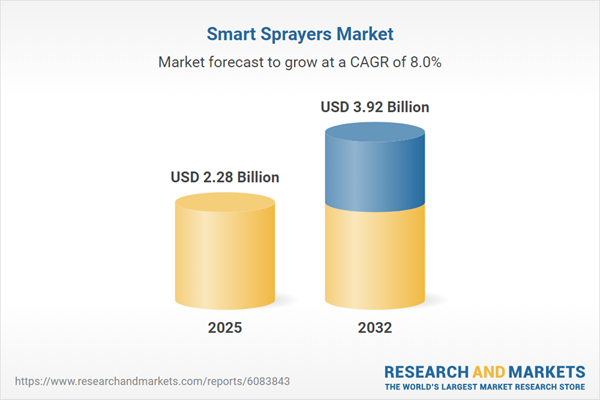Speak directly to the analyst to clarify any post sales queries you may have.
The smart sprayers market is accelerating digital transformation in precision agriculture, helping leaders achieve operational efficiency, sustainability, and next-generation crop protection. This report equips decision-makers with actionable insights to navigate technology shifts, evolving regulations, and regional adoption patterns.
Market Snapshot: Smart Sprayers Market Growth and Outlook
The Smart Sprayers Market expanded from USD 2.11 billion in 2024 to USD 2.28 billion in 2025 and is projected to reach USD 3.92 billion by 2032, registering a CAGR of 8.03%. Ongoing momentum is driven by digital agriculture’s convergence with sustainability mandates. Automated and integrated smart spraying solutions are transitioning rapidly from pilot projects into mainstream commercial adoption, as organizations prioritize greater input accuracy, resource efficiency, and compliance with stricter oversight. Stakeholders in agriculture, from growers to large enterprises, are shifting from conventional approaches to connected, data-driven equipment to drive precision and end-to-end traceability across a variety of crop types and environments.
Scope & Segmentation: Comprehensive Coverage of the Smart Sprayers Market
This report delivers granular analysis across key segments, ensuring B2B leaders can confidently align investment and operational priorities with emerging opportunities:
- Connectivity: Choice between IoT-enabled smart sprayers (cellular connectivity, satellite, Wi-Fi) and traditional non-IoT solutions for environments with distinct digital infrastructure capacities.
- Technology: Selection of autonomous ground units leveraging GPS or advanced vision-guidance, alongside conventional sprayers, drone-based delivery systems, and pneumatic spraying platforms to address diverse operational use cases.
- Applications: Deployments on agricultural farms, golf courses, horticultural nurseries, landscaping projects, and for pest control service providers, reflecting a wide spectrum of end-user needs.
- Crop Type: Equipment tailored for cereals, fruits, and vegetables, offering adaptability to distinct agronomic requirements and maximizing resource efficiency across specialty and staple crops.
- Operation Modes: Automated systems with varying levels of autonomy (Levels 3–5), semi-automatic configurations offering targeted modernization, and manual options for operators seeking staged digital integration.
- Regions: In-depth insights spanning the Americas (including the United States, Canada, Mexico, Brazil, Argentina, Chile, Colombia, Peru), Europe (UK, Germany, France, Russia, Italy, Spain, Netherlands, Sweden, Poland, Switzerland), Middle East & Africa (UAE, Saudi Arabia, Qatar, Turkey, Israel, South Africa, Nigeria, Egypt, Kenya), and Asia-Pacific (China, India, Japan, Australia, South Korea, Indonesia, Thailand, Malaysia, Singapore, Taiwan).
- Leading Companies: Detailed evaluation of product portfolios and strategic moves by key manufacturers including Deere & Company, AGCO Corporation, CNH Industrial N.V., Trimble Inc., Topcon Corporation, Valmont Industries, Lindsay Corporation, Kubota Corporation, Bucher Industries AG, and Raven Industries, Inc.
Key Takeaways for Senior Decision-Makers
- Smart sprayer technology delivers precise, site-specific agrochemical application, reducing waste and promoting responsible input use in diverse field settings.
- Integration with digital farm management and cloud-based analytics platforms streamlines real-time decision-making, while supporting rigorous compliance with changing government and industry regulations.
- Regional adoption patterns vary as local standards, infrastructure, and production practices shape preferences for technology type and connectivity, impacting deployment rates and investment priorities.
- Modular upgrades and retrofit kits allow cost-effective enhancement of older equipment fleets, enabling scalability of precision spraying without large-scale capital investments.
- Joint business models—engaging machinery providers, analytics companies, and service organizations—are advancing innovation cycles and influencing both procurement and customer support practices.
Tariff Impact: Navigating Trade Dynamics and Component Sourcing
Recent tariff actions in the United States targeting core electronic and precision components have driven up costs and disrupted traditional smart sprayer supply chains. In response, manufacturers are focusing on localizing sourcing for critical elements and adjusting designs to simplify production and reduce exposure to import barriers. This market shift is prompting many users to extend leases or explore retrofitting existing assets, as price fluctuations on new machines intensify purchasing complexities. Strategic partnerships across the supply chain remain vital for managing costs and optimizing logistics.
Methodology & Data Sources
This report combines primary interviews with manufacturers, technology developers, and end-users with quantitative surveys tracking operative adoption rates. Trade statistics, patents, and regulatory documents supply additional context, while benchmarking and scenario modeling supplement competitive and technology landscape analysis.
Why This Report Matters
- Supports senior leaders in accurately evaluating segment-level opportunities across key geographies and anticipating disruptive technology trends.
- Empowers teams to plan resilient supply chains, address compliance, and shape data-driven decisions for market entry or expansion strategies.
Conclusion
The smart sprayers market offers strategic insights for future-focused stakeholders seeking measurable improvements in sustainability, efficiency, and technology integration within digital agriculture.
Table of Contents
3. Executive Summary
4. Market Overview
7. Cumulative Impact of Artificial Intelligence 2025
Companies Mentioned
The companies profiled in this Smart Sprayers market report include:- Deere & Company
- AGCO Corporation
- CNH Industrial N.V.
- Trimble Inc.
- Topcon Corporation
- Valmont Industries, Inc.
- Lindsay Corporation
- Kubota Corporation
- Bucher Industries AG
- Raven Industries, Inc.
Table Information
| Report Attribute | Details |
|---|---|
| No. of Pages | 188 |
| Published | November 2025 |
| Forecast Period | 2025 - 2032 |
| Estimated Market Value ( USD | $ 2.28 Billion |
| Forecasted Market Value ( USD | $ 3.92 Billion |
| Compound Annual Growth Rate | 8.0% |
| Regions Covered | Global |
| No. of Companies Mentioned | 11 |









